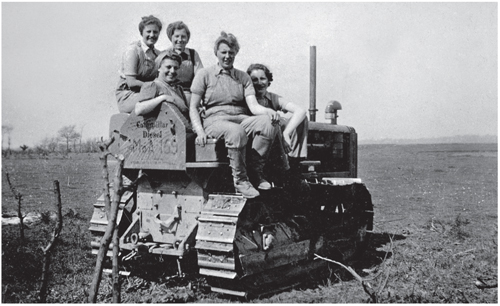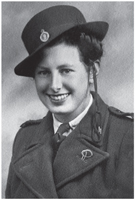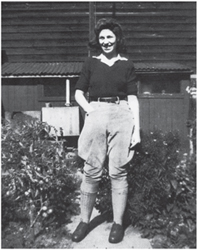Essex Land Girls (15 page)
Authors: Dee Gordon

There was also a speaker at Chigwell West Hatch High School in 1991 (who cannot now be traced) who spoke of the foreman measuring the distance between potatoes she planted when in the Land Army on a farm in Southminster – they had to be 14in apart. She spoke of sorting and tying rhubarb into ‘bunches’ of ‘five wide sticks, six medium sticks and two handfuls of small sticks’ and then moving on to train as a tractor driver, working between the Crouch and Blackwater rivers.
While some Land Girls spent literally years in just one place, others enjoyed a bit of variety, not only in the work they did but also the locations they worked in. They could be clearing fields at Bower Hall Farm in Mersea, cutting back derelict areas of overgrown scrubland in Rochford or Thaxted, or picking fruit at the Wilkins jam factory in Tiptree. (Interestingly, there was a bumper crop of cherries and plums in 1942 for Wilkins, partly testament to the work of the WLA, with a similar increase in the annual potato crop after the Land Army had ploughed up Blackshots playing field in Thurrock, also in 1942.)
They could be using old steam engines to plough up uncultivated meadows and common land, such as an area of 1,200 acres at Hornchurch, meaning that wheat could be grown there for the first time in forty years, producing much-needed bread for London and beyond. According to the
Chelmsford Chronicle
of 29 January 1943, a part of this latter task was to drag down ‘trees thicker than a man’ by chains attached to steam-driven ploughs, with overgrown hedges cleared in the same way.

Bower Hall Farm, Mersea, 1943, with Land Girls and the driver Frank Richer, clearing the lower fields with a caterpillar. (Courtesy of the David Green Collection at Mersea Museum)
Valentines Park in Ilford and Parsloes Park in Dagenham were among those partly dug up by the Land Army at a time when everyone was digging for victory, even if they only had an allotment or small garden. One of the Land Girls featured on the ‘Wartime Memories’ website refers to the girls in Valentines Park giving the soldiers on the ack-ack guns fresh vegetables. Similar use was made of many other parks in Essex, including Ray Park in Snakes Lane, Woodford, then owned by Bryant & May (the matchmakers), and providing work for five Land Girls who grew onions, carrots, cabbages and a variety of fruit – with part of the park used for rabbit production.
Parts of Epping Forest were also secured for growing vegetables. Even village greens, such as that at Great Bentley, were not safe – this was ploughed up on the orders of the Essex War Agricultural Executive Committee so that the area could produce potatoes, flax and peas, although the cricket club and football club escaped unscathed. On farms, in nurseries, parks, gardens and forests – Land Girls were everywhere.
There are references in the Essex Record Office to Land Girls working at a widespread array of farms, including Rawreth (Beeches Farm), Reeds Hill Farm (replacing ten men), and Burnt Mill Road, Benfleet, and in Kent’s Farm Nurseries, Holland-on-Sea, whose main crops were cucumbers and tomatoes grown in extensive glasshouses.
There were also Land Girls at Downe Hall Farm, near Roydon, run by Mrs Beryl Abbey who was originally famous as a breeder of goats but had diversified into cattle, and was apparently then living in genteel decay. Beryl Abbey had lived in great affluence breeding dogs at the time of the First World War, and noticed that they thrived on goats’ milk, so she bought one – and became the ‘Godmother of British Alpine Goats’, until the crash of 1929. During the Second World War, she contributed a monthly spot on the BBC called
Goat Keeping in Wartime
(see the
British Goat Society Monthly Journal
of January 2011).

Joan Culham at Miller’s Farm, Wakering. (Courtesy of Millers Farm and John Street)
John Threadgold, of Miller’s Farm in Great Wakering, remembered his parents employing Land Girls at their farms. Specifically, he spoke of Audrey Capp at Oxenham Farm, who was about 17 and weighed only 8 stone ‘but could lift a 1½ cwt sack of oats on her shoulders and put it in the granary’. Audrey also did the milk round on Foulness using a horse and cart. She arrived in 1941, and was followed a year later by Joan Culham, a tall girl (over 6ft) from Southend-on-Sea who stayed at Miller’s Farm.
Probably the unluckiest Land Girl of them all was 18-year-old Jean Lakin. Based at Mark Hall in Harlow, she was sitting on the shaft of a horse and cart when it went through a gate, at Kitchen Hall Farm, knocking her off, with fatal consequences. The Land Army placed a memorial in the vestry of Latton church at Harlow, recording her death on 27 September 1944.
Harlow Land Girls had been particularly unlucky, with another funeral – that of Doreen Francis, aged just 17 – having taken place in February 1943. Twenty members of the WLA formed ‘a guard of honour’ at Doreen’s funeral with Mrs Tom Howard ‘representing Mrs Solly-Flood, the Organising Secretary of the WLA’ according to the
Harlow Gazette
. A wreath in the shape of the WLA badge was among those in evidence.
Gas attacks were something that Land Girls prepared for, but which thankfully didn’t actually happen. They learnt how to deal with gassed animals, how to protect chicken coops and cowsheds with dampened sacks, and how to treat blistered cattle. Animals would have had to be led to decontamination areas, where their sores could be treated, and the girls picked up such tips as how to protect horses’ eyes with bandages soaked in the horse’s own urine. Such a hazard threatened not only the animals but the Land Girls themselves, although the danger diminished as the months passed.
More commonly, bulls feature in a number of the more hazardous stories told by members of the WLA.
Florence Rawlings
spoke of being knocked over by one who was scared by a snapping dog, and there was a report in the
Chelmsford Chronicle
(24 September 1943) of a bull attacking ‘Land Girl Joan Catch at Aylen’s Farm, Hornchurch’ resulting in her spending ‘time in Oldchurch hospital’. The same newspaper, in January 1943, refers to an attack on Ruth Cunningham and Mary White, and this is given in more detail in the
Harlow Gazette
:
Employed by Mr J.W. Soper, of New Hall Farm, Harlow, Miss Ruth Cunningham, aged 21, whose home address is 11a Elington Road, Chingford, and Miss Mary White, aged 18, of 68 Dall View Avenue, Chingford, were repairing a fence on Harlow Common on Saturday when a bull approached Miss Cunningham. Warned by Miss White, Miss Cunningham chased the bull away. It afterwards returned and attacked her, knocking her down and rolling her over. On seeing her companion’s danger, Miss White dragged her comrade through the fence to safety. On hearing screams, the foreman of the farm rushed to the scene and found Miss Cunningham badly bruised and cut in several places. After being carried to the farm, Miss Cunningham was taken to her billet at Cheshunt Cottage, High Street, Harlow … an ambulance removed Miss Cunningham to her home. [She] has been in the WLA for over two years and previously worked in the office of Connaught Hospital, London. For six months, Miss White has been a member of the WLA, being employed at Barclays Bank, London, previously.
An interesting variant on this theme was the attack by a bull on ‘Mr A. Hammond’ at his farm – the Outwood Dairy Farm at Billericay – in February 1945, again reported in the
Chelmsford Chronicle.
This time it was ‘Mrs C. Moughton, a WLA girl’ who came to his rescue, ‘holding the bull off with a pitchfork’ until it had ‘been secured’ by some of the farmhands. Mr Hammond ‘sustained a fractured rib and collar-bone’.
Falls, from ladders, hayricks, and horses were everyday occurrences, regarded as part of the job.
Irene Verlander
fell off a ladder in one of the orchards she worked for, but was dismissive of the resultant bruises. One girl fell off ‘the top of a stack, threw her pitchfork down and landed on it – nasty’, remembers
Winifred Daines
. A similar fall from a haystack when using a pitchfork left
Elsie Haysman
in some pain, but at least she didn’t land on the pitchfork.
A fall from a shire horse was another accident that befell
Florence Rawlings
. She had to ride it to Hanningfield from Ramsden Bellhouse to get it shod at the farrier, but it was uncomfortable and she eventually fell off on one trip, needing the help of a passing farmer to get back on.

Irene Verlander (née Hart) in the sunshine. (Courtesy of Linda Medcalf)
The
Ilford Guardian
of 28 August 1943 refers to WLA girl ‘Miss Cecilia Cripps, 17, of Henley Road, Ilford’ who had a ‘narrow escape from serious injury when she was trapped by an over-turned horse and cart … she was employed by Mr R. Radbourne, a farmer at Latton, Harlow … She sustained a bruised back and was taken to Haymeads Hospital, Bishops Stortford.’
The tools and machinery that were part and parcel of the workplace meant different kinds of risks being undertaken, without any thought of injury. As
Winifred Daines
said, ‘There were no first aid boxes in spite of very sharp tools.’ She remembers one girl ‘losing the top of her finger’. One Land Girl, reminiscing in
Reveille
(24 October 1975), spoke of ‘baling so much hay that your hands were covered with blisters. Then you had to burst the blisters and milk fourteen cows.’ Blisters were also a problem for
Irene Verlander
and
Gladys Pudney
; the latter recommended a treatment of ‘lard and sugar’, but she didn’t say if it worked!
Winnie Bell
ended up with her ‘thumb in plaster for six weeks’ after getting a bit too close to the working parts of a threshing machine, and
Vera Pratt
was left with a scar on her right hand after the ‘bloke next to her’ dropped the knife he was using to cut kale – on to Vera’s knuckles.
The girls also had to be careful to protect their eyes from the chaff and from sharp appendages or anything thrown at them by Mother Nature. When using a ditch as a latrine, for instance, you had to keep a sharp eye out for wasps’ nests! One girl in
Winifred Daines
’ billet finished her day with ‘a thorn in her eye’ and Winifred ‘had to get two other girls to hold her still so we could remove it’, although it seems that eventually her crying washed it out. Fire was another everyday hazard, although two WLA girls employed by Mr Smith of Franklyn’s Farm in Harlow actually assisted the Harlow Fire Service when they were called to a fire at the farm.
The manual issued to all volunteers in the WLA gave some help with first aid for bites, chilblains, chapped hands, cracked thumbs, scratches, styes, and dealing with a nail that had penetrated a shoe. These were obviously the most common of the everyday complaints.
Lillian Woodham
remembers working on the land, horse hoeing, close to Romford Aerodrome, when she heard German fighters in the distance, and ‘hurried to hide’ herself and the horse ‘behind a tall hedge’. In her haste she ‘turned the horse and myself too fast, causing him to stamp on my foot. In the soft soil, my foot [must have sank] about six inches. By the time I got my foot out, the Germans had passed over.’ Similarly, a heavy cart horse trod on
Dorothea Strange
’s toe, a painful experience she was able to recall, but which had no impact on her work rate.
